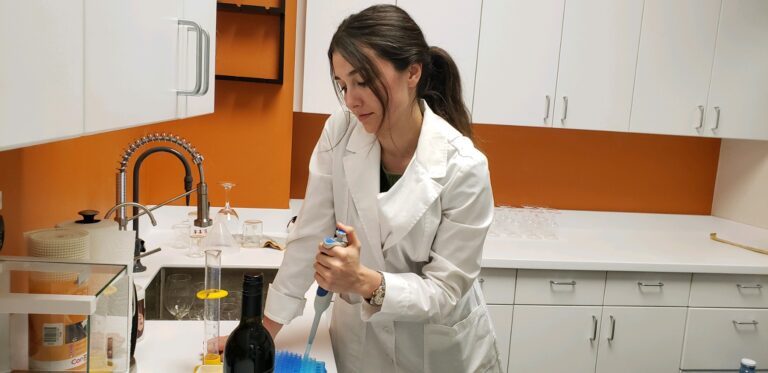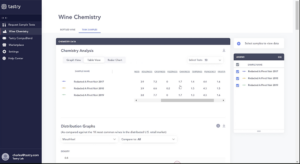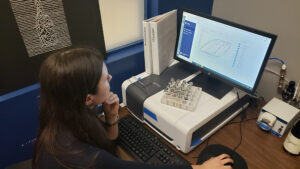
Wineries are starting to use artificial intelligence (AI) to predict which wines an individual is going to like before they try them, sometimes even before they become aware of them.
“We can predict the Vivino (Wine Rating System) score with 93% accuracy just by looking at the chemistry of the wine,” said Katerina Axelsson, founder and CEO of Tastry, which uses technology that compares information about a wine’s chemistry with a database of 248 million consumer palates. “We’ve been in the industry for several cycles, so winemakers and wineries can see what they submitted to us is what actually happened.
“One of the biggest reasons, especially going into this year, that a winery should use Tastry is to find the consumers that are going to be loyal, repeat customers,” she said. “We have this belief that every wine is a Screaming Eagle for someone out there. Your wine has a market for it; the challenge is how do you get to those consumers without wasting all your marketing money?”
“Using [this] technology, I can understand instantly the market size for a particular wine and also the best way to optimize a wine based on its intended audience, be it retailer or consumer,” said Cameron Hughes, founder of de Négoce, which sources and sells thousands of premium wines directly to consumers. “Katerina Axelsson basically taught a computer to taste wine.”
Helping Smaller Wineries
Tastry helps provide solutions to the challenges faced by smaller wineries.
“We found that small- and medium-sized producers struggled to be seen among the corporate giants who dominate distribution and digital channels,” states the company website. “This led to the creation of an in-winery experience that powers virtual tasting of the complete line of that producer’s product.”
Axelsson said when AI is properly applied, the return on a winery’s investment is $44 to $215 for every dollar it spends using the technology.
She described Tastry as “a vertically integrated product.”
“We have been referred to as the matchmaker in the industry,” she said. “We connect retailers and wineries, we connect wineries and consumers, we connect retailers to consumers, and now we’re connecting distributors to wineries and retailers.
“We touch the entire supply chain, and we’re only a team of 30 people,” she continued. “Shifting the paradigm of any industry is an ordeal in and of itself, so we figured we needed to have discipline and focus on doing one thing really well.”
There have been serious temptations to get Tastry to stray from that goal. Major corporations such as Pepsi, British American Tobacco and Nestlé have all inquired about using Tastry in their industries, according to Axelsson.
“We’ve had to be very disciplined and say, ‘No, we’re really focused on the wine industry right now,’” she said.

Tastry currently has limited, if any competition, according to Axelsson.
“I wouldn’t say I have any direct competitors,” she said. “If we have any competitors at all, it would be like an adjacent competitor that’s pursuing the attention of a consumer, but when it comes to the technology, I haven’t found a better answer than we really are the first company to do something like this, whether you look at the technology or the business model.”
Origins
Axelsson attended California Polytechnic State University, San Luis Obispo where she studied chemistry and winemaking, graduating with a B.S. degree in chemistry.
“I paid my way through college by working in the wine industry,” she said, estimating there are about 400 wineries in a 40-mile radius around the university. She did various jobs for some of those wineries before ending up working in a winery lab.
“I was young and ambitious, and curious,” she said. “I started to notice idiosyncrasies and pain points in the wine industry. The biggest thing I noticed was wineries were investing a lot of years, and in some cases millions of dollars, in making a wine for consumers. It’s kind of a shot in the dark; you’re dealing with nature and you can manipulate the outcome of the chemistry to an extent, but it’s a very reactive process, and what your preferences are or what your vision for the final product is doesn’t always correspond to whether the consumer likes it.”

Axelsson described the winemaking process as “very intuitive and not data-driven.” She noted there was an 85% failure rate when launching any kind of wine.
“The reason for that failure rate, I learned, is because you can sell someone almost anything once,” she said. “You can pick up a bottle of wine because it has a nice label or it looks interesting, but if you don’t like what’s in the bottle, you’re not going to buy it again, and the product is going to fail because it can’t get repeat purchases.”
Axelsson had “a hypothesis” that there was a way to understand what consumers really like and what their flavor preferences really were.
“If we were looking at the chemistry, we were looking at chemistry as a quality control mechanism,” she explained. “We weren’t looking at how consumers perceive that chemistry.”
Axelsson started Tastry based on the results of a two-year research project to determine if there was an analytical chemistry method that could break down the flavor matrix and relate it to the human palate.
“It turns out there’s a way to do that,” she said, adding that discovery resulted in Tastry eventually incorporating in 2016.
“We just incorporated so we could get an SBA loan to get our own analytical equipment, and we could start running experiments,” said Axelsson. “At that point, it was just myself and a Ph.D. in mathematics, and one other person. For two years since mid-2016, it was just a research project. It wasn’t until December 2021 that we launched an actual commercialized solution.
“When I started, I thought the challenge would be to build this revolutionary technology,” she said. “It took many years and millions of dollars, and the faith of a lot of people who might never get a return on their investment. I thought that would be the hard part.”
Instead, the biggest challenge Tastry faced was convincing winemakers to think about things differently and change the way they have been doing things their entire life, said Axelsson. “When it comes to AI, especially with a traditional industry like the wine industry, it’s not a ‘you build it and they will come’ kind of thing. There was a lot of education that had to take place, a lot of relationships had to be built, and we had to establish trust in the industry.
“We have worked really hard to establish trust with the top wineries, and we have a lot of winemakers on our website that publicly share their endorsements or the case studies they have had with Tastry,” she added.
“Tastry can do in an hour what would take weeks to do, and give you options depending on your target audience and price point, allowing winemakers to optimize their wines for their audience in a way never achievable before,” said Hughes. “Tastry doesn’t tell you how to make wine; it just gives you various options, saves you huge amounts of time, and, at the end of the day, you pick the wine you want to sell.”
“It might seem a little odd to use AI at first, but when they see what it actually is and how it’s applied, the fear of it being ‘the Terminator’ or anything like that dissipates pretty quickly,” said Axelsson. “It’s not what you imagine it is. It’s just another tool in the toolbox, and it’s just another paintbrush for the artist.
“It’s been an incredible tool for so many businesses,” she added. “We’ve saved entire productions, especially during smoke season, and I think we’re going to be seeing a lot more of that this year.”
One winery saved $10 million worth of smoke-tainted fruit when Tastry’s AI technology provided a recipe within 24 hours, just before the fruit had to be dropped, she said.
For more information about Tastry, visit the company website at https://tastry.com.











